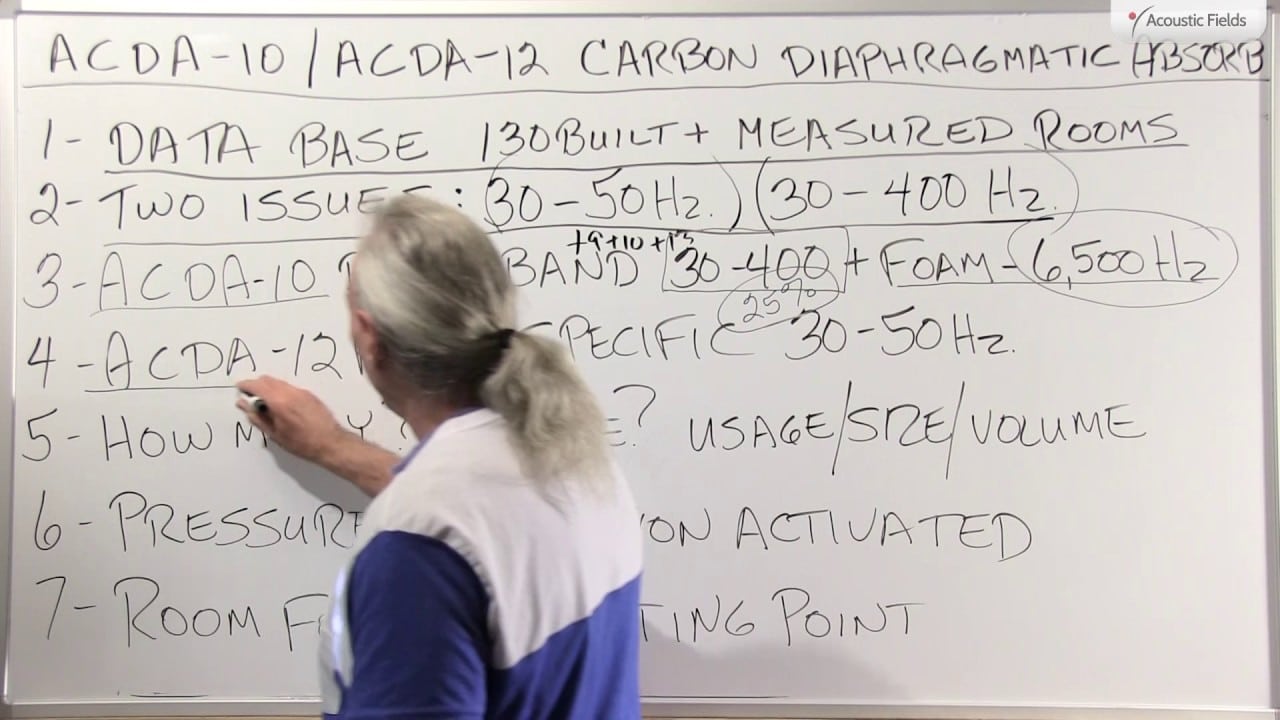Today we’re going to talk about our most important product in our company, we have two that we’ve created, one is the carbon technology and the others are foam technology but today we’re going to talk about our ACDA 10 and our ACDA12 units, those are our Carbon Diaphragmatic Absorbers.
Those of you that have been with us for a long time and our current customers know how powerful these units are so I kind of want to walk you through a little bit about them, describe them to you, the features and the benefits so you can get a handle on them. As you all know from past videos and stuff we really have an extensive database of 130 I think, now 132 built in measured rooms and in these built and measured rooms.
I took all that data years ago and I said let’s look at the common problems that these rooms have because the smallest room size is ten by ten by ten and I think the largest room size is 40 by 40 by 40 so we have everything in between those two extremes, What did I notice? I noticed two main issues in the data; I noticed that the frequency range from 30 to 50 cycles was always there, almost no matter what room size you had. So 95% of our rooms between those two extremes we had problems in this area and they were serious problems, they were plus 9, plus 10, plus 13 DB bumps so we all know from past experience that we don’t want those so those are really bad and those are the hardest frequencies to deal with. Then I also noticed another more broadband issue from 30 to 400 Hz so those are the two main areas that I focused on when I created the technology.
So for the broadband more approach for the 30 to 400 cycle range I created the ACDA Canon and the beautiful thing about this product is it’s nice and even in terms of absorption with an absorption coefficient of about 25% across the board and then if you add our foam to the face you can really increase the upper limits of absorption up to 6500. Then we really went after that really problematic range from 30 to 50 Hz and that’s a really powerful boomy range especially for home theater and things like that so we came up with the technology used in our carbon to really address this issue and if you look at the absorption coefficients of it at 30 cycles were about 35%, at 40 were 63% and at 50 were a 100% so you have a really powerful sponge with the ACDA 12 to go after that 30 to 50 cycle range so that’s a really strong product. Now very heavy, 250 pounds, this is serious technology this isn’t a Band-Aid, can’t hang it on the wall it’s not foam, it won’t address the same issues, it’s a low frequency absorber for really large amounts of energy.
So the goal here is to have two tools that we can use in our rooms to absorb the big percentage of the problems. Now, how many and where we put them in the room is all dependent on usage size and volume. You’ve got to know what you’re doing, how big the room is and how much volume we have to work with for the low frequency energy and these are pressure and reflection activated devices so they have to go in certain positions of the room. How many, where, it depends on what you’re doing in the room and the easiest way to figure that out and to get assistance and guidance is to fill out our room form and there’s plenty of places on our website you can do that. So there’s an overview of our ACDA10 and our ACDA 12 carbon absorbers and if you need help with those issues in your room and almost everybody does, fill out the room form and send it to us.
—
This is an unedited transcript from our video series from Acoustic Fields. There will be some errors in grammar and sentence structure that occur during this translation process.
For complete understanding and comprehension, please view the video which is included in this text. For any additional information regarding this topic or others relating to room acoustics, please contact us directly at:
P: 520 – 392 – 9486







